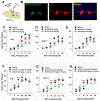New Drugs, Old Targets: Tweaking the Dopamine System to Treat Psychostimulant Use Disorders
- PMID: 33411583
- PMCID: PMC9341034
- DOI: 10.1146/annurev-pharmtox-030220-124205
New Drugs, Old Targets: Tweaking the Dopamine System to Treat Psychostimulant Use Disorders
Abstract
The abuse of illicit psychostimulants such as cocaine and methamphetamine continues to pose significant health and societal challenges. Despite considerable efforts to develop medications to treat psychostimulant use disorders, none have proven effective, leaving an underserved patient population and unanswered questions about what mechanism(s) of action should be targeted for developing pharmacotherapies. As both cocaine and methamphetamine rapidly increase dopamine (DA) levels in mesolimbic brain regions, leading to euphoria that in some can lead to addiction, targets in which this increased dopaminergic tone may be mitigated have been explored. Further, understanding and targeting mechanisms underlying relapse are fundamental to the success of discovering medications that reduce the reinforcing effects of the drug of abuse, decrease the negative reinforcement or withdrawal/negative affect that occurs during abstinence, or both. Atypical inhibitors of the DA transporter and partial agonists/antagonists at DA D3 receptors are described as two promising targets for future drug development.
Keywords: JJC8-091; VK4-40; cocaine; dopamine D3 receptor; dopamine transporter; methamphetamine; modafinil.
Figures




References
-
- NIDA. 2019. Overdose Death Rates. https://www.drugabuse.gov/related-topics/trends-statistics/overdose-deat...
-
- DEA. 2017. 2017 National Drug Threat Assessment. https://www.dea.gov/documents/2017/10/01/2017-national-drug-threat-asses...
-
- News KH. 2019. Meth Vs. Opioids: America Has Two Drug Epidemics, But Focuses On One.
-
- CDC. 2020. Provisional Drug Overdose Death Counts.
Publication types
MeSH terms
Substances
Grants and funding
LinkOut - more resources
Full Text Sources
Other Literature Sources
Medical
Research Materials

